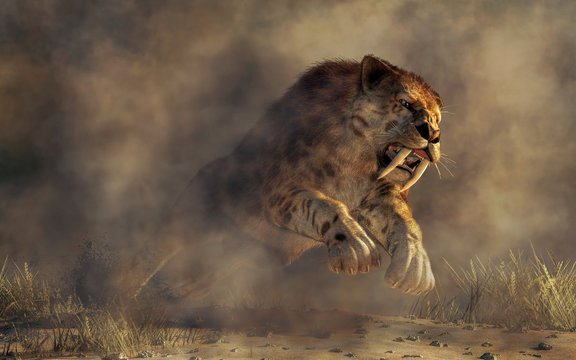The Enigmatic Saber-Toothed Cats: Masters of the Prehistoric Hunt
Presentation:
Saber-toothed felines, logically known as Smilodon, were a striking gathering of ancient hunters that wandered the Earth during the Pleistocene age, around 2.5 million to quite a while back. Described by their fearsome saber-like canine teeth, these great animals have caught the minds of researchers and aficionados the same, adding to how we might interpret the antiquated biological systems they once ruled.
Actual Attributes:
One of the most particular highlights of saber-toothed felines was their great sets of extended canine teeth, which could grow up to a foot long. Regardless of their name, these felines were false tigers or lions but rather had a place with a different family, the Machairodontinae. Their vigorous bodies and more limited appendages contrasted with current huge felines recommend variations for a particular hunting technique.
Territory and Dispersion:
Saber-toothed felines were far and wide and versatile, with fossils found on different landmasses. They involved a scope of conditions, from open fields to thick backwoods. Fossil proof demonstrates that various types of saber-toothed felines adjusted to different environments, displaying their capacity to flourish in different scenes.
Hunting Technique:
The famous saber-like canines were not only to look good; they assumed a urgent part in the felines' hunting methodology. Researchers accept that saber-toothed felines utilized their noteworthy teeth to convey exact, deadly nibbles to the delicate underside of their prey. Dissimilar to the present huge felines that frequently choke out their prey with a throat chomp, saber-toothed felines depended on a more determined approach, keeping away from pointless gamble during the chase.
Species Variety:
While the most well known individual from the saber-toothed feline family is Smilodon, there were various different species with remarkable variations. Some had more strong forms, while others were all the more delicately fabricated, proposing a scope of natural jobs inside their separate environments. Famous species incorporate Smilodon fatalis, tracked down in North and South America, and Homotherium, which had a more worldwide circulation.
Termination:
In spite of their prosperity as dominant hunters, saber-toothed felines at last confronted elimination. The explanations for their downfall are as yet bantered among researchers, with elements, for example, environmental change, rivalry with different hunters, and changes in prey accessibility being thought of. No matter what the reason, the vanishing of these great hunters denoted the conclusion of a significant time period in Earth's set of experiences.
Heritage and Social Effect:
Saber-toothed felines have made a permanent imprint on mainstream society, as often as possible showing up in books, films, and craftsmanship. Their particular appearance and secretive eradication have made them getting through images of the ancient world. Scientistss keep on concentrating on their fossils, revealing new bits of knowledge into the existences of these intriguing animals and the environments they once dominated.
End:
Saber-toothed felines, with their amazing actual transformations and exceptional hunting systems, were imposing hunters that flourished for a long period of time. In spite of the fact that they are never again part of our planet's fauna, their heritage lives on through the investigation of fossils, giving significant data about the elements of antiquated biological systems and the fantastic variety of life that once existed on The planet
